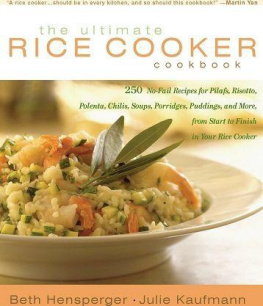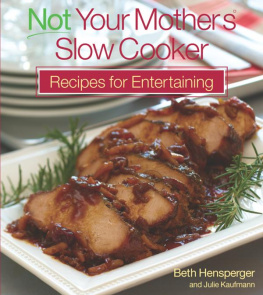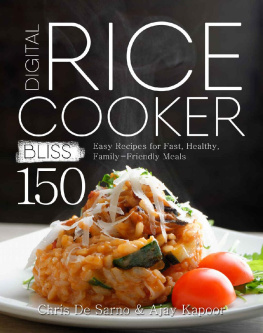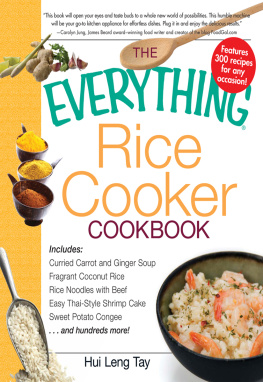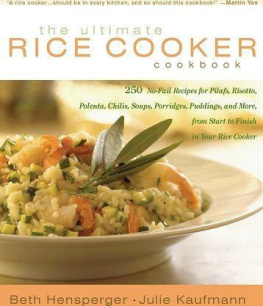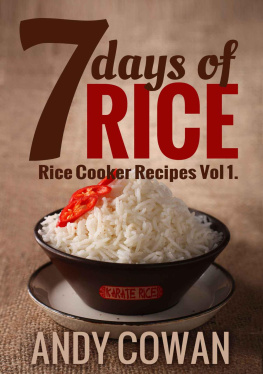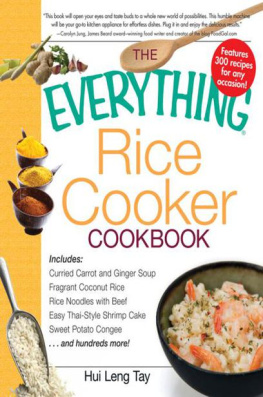

ALSO BY BETH HENSPERGER Bread Baking Bread Bread for All Seasons Beths Basic Bread Book Breads of the Southwest The Bread Bible The Pleasure of Whole Grain Breads Bread Made Easy Bread for Breakfast The Best Quick Breads The Bread Lovers Bread Machine Cook book

THE HARVARD COMMON PRESS
535 Albany Street
Boston, Massachusetts 02118
www.harvardcommonpress.com
2002 by Beth Hensperger and Julie Kaufmann
Illustration 2002 by Michael Cox
First paperback printing March 2003
All rights reserved. No part of this publication may be reproduced or transmitted in any form or by any means, electronic or mechanical, including photocopying, recording, or any information storage or retrieval system, without permission in writing from the publisher.
Printed in the United States of America
Printed on acid-free paper
The Library of Congress has cataloged the
hardcover edition as follows:
Hensperger, Beth.
The ultimate rice cooker cookbook : 250 no-fail recipes for pilafs, risotto, polenta, chilis, soups, porridges, puddings, and more from start to finish in your rice cooker / Beth Hensperger and Julie Kaufmann.
p. cm.
ISBN 1-55832-202-7 (hc : alk. paper)
1. Cookery (Rice) I. Kaufmann, Julie. II. Title.
TX809.R56.H44 2002
641.6318dc21
2001039603
Special bulk-order discounts are available on this and other Harvard Common Press books. Companies and organizations may purchase books for premiums or resale, or may arrange a custom edition, by contacting the Marketing Director at the address above.
10 9 8 7 6 5 4 3 2 1
Jacket design by Night & Day Design
Book design by Marysarah Quinn
Text illustration by Michael Cox
These recipes were tested at sea level. If you are cooking at an altitude of over 3,000 feet, you may need to add additional liquid, especially when cooking brown rices.
for GUHAN TOM DAVIS
heart-to-heart and a bowl of Thai jasmine

for MAX, MAYA, MOM, and BEN, who started it all
contents
The rice angel is a guardian for people who appreciate rice. We met a lot of angels disguised as humans who not only appreciate, but unabashedly love rice and their rice cookers, while working on this book.
Thank-yous to the following for contributing their time and expertise to this work: food writer Lynn Alley; Aunt Joan Billheimer; Naoko Boerger; Matthew Bun son; Paul Mizukia, Michelle Camerlengo, and Jim Rogers of Panasonic/Matsushita Consumer Elec tronics Company; California Cooperative Rice Research Foundation, Inc., Biggs, California; Paul Cha; barley lover Jean Clem of Western Trails Food Products; Jesse Cool; restaurateurs and culinary intelligentsia Elaine Corn and David SooHoo of Bamboo Restaurant, Sacramento, California; Joyce Gemperlein; Joyce Goldstein, for her generous information on Italian rices; Barbara Grunes; Glenda Hildon of Rice Specialty, Inc.; Judith Dunbar Hines; Hitachi America Limited; Ming-man Hsieh; Atsuko Ishii; Sharon Jones, for the big burlap bag of Daawat basmati; Asian food specialist and San Francisco Chronicle columnist Joyce Jue; Carolyn Jung; Caryl Levine and Ken Lee of Lotus Foods; Grace Liu; Deborah Locke of RiceTec, Inc.; Amanda Lorenzo of Aroma; Jacquie McMahan, the matriarch of California rancho and Mexican cooking; plant breeder John Neal of Lundberg Family Farms; Tamera Moore, for critiquing all the rices; Marianne New of Zojirushi America Corporation; Sharon Noguchi; Mexican culinary tour guide Marge Poore; Toni Ramsaur of Gibbs Wild Rice; food writer Rick Rogers; Kimberly Park of the USA Rice Federation, Houston, Texas; Diana of Sanyo Electronics Company; creative consultant Julia Scannel; Hiroko Shimbo; U.S. Department of Agri culture Agricultural Research Center, Beaumont, Texas; Mary Weide, for sharing all that Thai jasmine; Andrew Whitfield, who taught Beth how to cook short-grain brown rice; Williams-Sonoma; Feng-Chih Lucy Wuchen; Martin and Susan Yan. And to all of the members, past and present, of the English Conversa tion Club at Escondido Elementary School for so generously opening their kitchens and their hearts.
Our thanks also go to Pam Hoenig and Julie Stillman for their marvelous editing; Valerie Cimino, managing editor; the sales, marketing, production, and publicity managers and assistants at Harvard Common Press; and Martha Casselman, our stalwart and dedicated literary agent, who loves leftover rice in her soup.
Hajim choro choro
Naka pa ppa
Akago nait mo
Futa toru na.
At first it bubbles
And then it hisses
Even if the baby is crying
Dont remove the lid.
Japanese nursery rhyme on how to cook rice
translated by Elizabeth Andoh
Once upon a time, rice was just ricein our lives anyway. You planned a meal and rice seemed to be the right starch to serve with it. You placed the saucepan on the stove, measured some water into it, pulled down the bag of rice, measured it into the cup, and poured it into the boiling water. As the water came back to a boil, on went the cover and, when the timer beeped, you ate the rice.
That was before we met the rice cooker. Since then, the world of ricethe amazing array of rice available on every supermarket and specialty grocery shelf, where it grows, its lore and history, sharing recipes, the writing of this bookhas become an everyday part of our lives.
To an American cook, the electric rice cooker has been, up to now, a take-it-or-leave- it kitchen appliance. I mean, whats a stove for? But to many Asian-American cooks and cooks throughout Asia, the rice cooker is an absolutely essential appliance for everyday meal preparation. It is the method of choice for cooking rice in Japanese and Chinese restaurants (most of the rice cooker manufacturers have a commercial division). Since in many of these diets rice is eaten three times a day, the rice cooker is always on in every home. There are even small ones with a handle to carry while traveling on vacations and business trips. Well, why eat less-than-perfect rice when you dont have to?
Rice cookers appeal to a busy cook for a number of reasons, the first being you may have heard one of your friends tell you how great it is. It is an appliance well suited to a limited cooking space (it is the cooking tool of choice in college dorms and is great up at the ski cabin) and boasts easy cleanup. It is a closed-environment, slow-cook method that has ended up a cross between a countertop slow cooker, an oven clay pot, and a stove top saucepan. Since it is a one-button technology, there is virtually no maintenance.
There is not much written about rice cookers in general. I will be interested in seeing what you can do with the rice cooker, Janice Cole, professional cook and editor of Cooking Pleasures magazine, told us. I have never made anything but plain rice in mine. This is the sentiment shared by the majority of cooks we talked to. Beyond the slim pamphlet enclosed with the unit, not much information on how to use it exists in print. In Asia, a rice cooker is part of a normal household, Julie explained during one of our early discussions about the appliance. It is like an iron or a toaster here. Why write a book about how to use an iron or toaster? Everybody just knows.
So, here is a book that fills that gap. How to use your rice cooker to make foolproof everyday basic rice, recipes for the new rices on the market, and beautiful pilafs make up the core of the book. But there is a host of other possibilities, from risottos and hot breakfast cereals to incredible desserts, made start to finish in your rice cooker. Dim sum and sushi rice, often intimidating, are within the grasp of even the novice cook. But if all you want is to make some good plain rice, this book is also for you. All instructions are presented as simply, but also as comprehensively, as possible, to be of practical use in every type and size of machine.
Next page
